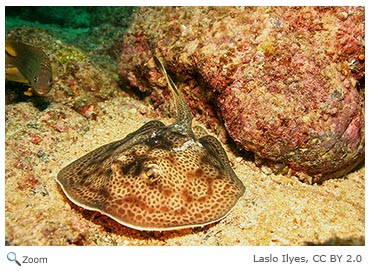 The species in this family of rays are found in tropical and temperate waters of North, Central and South America. The species in this family of rays are found in tropical and temperate waters of North, Central and South America.
Round rays are found on the ocean bottom, usually partially buried in the sand. Their coloration helps to camouflage them from both predators and prey.
Round rays have round or oval pectoral fins, thin tails, no dorsal fins, and a venomous tail spine.
Round rays eat small fish and invertebrates.
World Status Key
 Least Concern Least Concern  Near Threatened Near Threatened  Vulnerable Vulnerable  Endangered Endangered  Critically Endangered Critically Endangered  Extinct in Wild Extinct in Wild  Extinct Extinct  Not Enough Data Not Enough Data
Status and range is taken from ICUN Redlist.
U.S. Status Key
 Threatened in US Threatened in US  Endangered in US Endangered in US  Introduced Introduced
Status taken from US Fish and Wildlife. Click on U.S. status icon to go to the U.S. Fish and Wildlife species profile. |
|
New Hampshire Status Key
 Threatened in NH Threatened in NH  Endangered in NH Endangered in NH  Breeds in NH (birds) Breeds in NH (birds)
Status taken from NH Fish and Game |
Location Key
 Africa Africa  Asia Asia  Australia/Oceania Australia/Oceania  Europe Europe  North America North America  South America South America  NH NH  Click for More Info Click for More Info  Click for Image Click for Image
 Arctic Ocean Arctic Ocean  Atlantic Ocean Atlantic Ocean  Indian Ocean Indian Ocean  Mediterranean/Black Sea Mediterranean/Black Sea  Pacific Ocean Pacific Ocean
Additional Information
Key:  Profile Profile  Photos Photos  Video Video  Audio Audio
Bullseye Round Stingray - Urobatis concentricus     
The bullseye round stingray is also known as the spot-on-spot round ray. It is found along the coast of western Mexico.
Source: Arkive Intended Audience: General Reading Level: Middle School Teacher Section: Yes
Round Stingray - Urobatis halleri     
The round stingray is found in the Pacific Ocean from California to Panama.
Source: Florida Museum of Natural History Intended Audience: General Reading Level: Middle School Teacher Section: Yes
Round Stingray - Urobatis halleri     
The round stingray feeds on bottom dwelling invertebrates and small fish.
Source: Aquarium of the Pacific Intended Audience: General Reading Level: Middle School Teacher Section: Yes
Yellow Stingray - Urobatis jamaicensis      
The yellow stingray is found along in the Atlantic Ocean from North Carolina south to Venezuela, along the Atlantic coast of Central America, and throughout the Caribbean and the Gulf of Mexico.
Source: Florida Museum of Natural History Intended Audience: General Reading Level: Middle School Teacher Section: Yes
|

